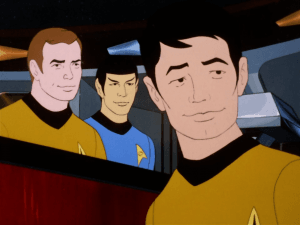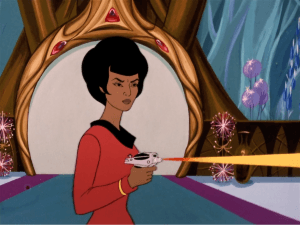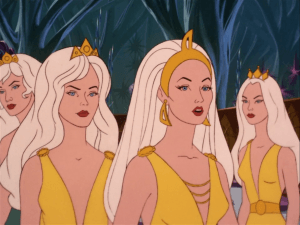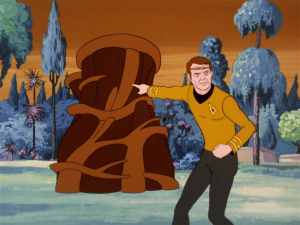
Hello and welcome to the latest ‘Final Frontier Friday’. It’s an animated outing this week as we celebrate International Women’s Day with a look at ‘The Lorelei Signal’. Yes, I know Women’s Day was yesterday, but if it helps I was writing this on the eighth. That counts, right?
One of the first handful of animated episodes produced, ‘The Lorelei Signal’ is one of several written by former original series contributors. In this case, it was Margaret Armen, whose contributions to the original ‘Star Trek’ included ‘The Gamesters of Triskelion’, ‘The Cloud Minders’, and ‘The Paradise Syndrome’. In addition to ‘The Lorelei Signal’, she would write the subsequent animated episode ‘The Ambergris Element’. Later in the seventies, Armen would also co-write an episode for the aborted ‘Star Trek: Phase II’ series. Called ‘The Savage Syndrome’, the episode would have seen the crew cope with a technology that unleashed the darker impulses that humans (and Vulcans) ordinarily repress, turning the Enterprise into a battleground.

But why cover ‘The Lorelei Signal’ for International Women’s Day? Well, it’s simple really. If you’ve even heard of the episode, you can probably guess why. See, if this one is famous for anything, it’s for being the one time in ‘Star Trek’ history that Uhura has explicitly taken command of the Enterprise. So welcome was this development that David Gerrold later recalled Nichols’ reaction to the script being a gleeful “At last!” But was the story worth the wait?
The Enterprise is investigating a sector where a number of Federation, Klingon, and Romulan vessels have disappeared, at the unusually consistent rate of one every twenty-seven years. The ship receives a strange subspace signal, which Uhura says is more music than a message. Simultaneously, Spock reports that the ship is being probed by a scan originating in the Taurean system. En route to the Taurean system, the men all seem markedly distracted. When Nurse Chapel arrives on the bridge (at Uhura’s request) the men begin experiencing visions or hallucinations, though the women remain unaffected. As they approach the system, the signal grows stronger. Upon arrival, they enter orbit of Taurea II, where Kirk beams down with a landing party. Meanwhile, Uhura begins spotting errors in Spock’s data. On the planet’s surface, the (increasingly distracted) all-male landing party investigates a building where they are greeted by a party of women, including one who introduces herself as Theela, the “Head Female.” Despite having just met them, Theela knows an awful lot about Kirk and the others. Though she promises to explain the signal later, Theela not-at-all ominously invites Kirk to a feast that is being held to celebrate their arrival.
 While in the company of the Taurean women, the landing party progresses from distraction to delirium. When asked about the men, Theela says they are “in another compound,” which Kirk uncritically accepts. Soon after, Spock and the others collapse and Theela has them taken away. When they come to, they are all wearing golden headbands and appear noticeably older? Back on the Enterprise, Chapel has had the relevant scans redone by female crew members. The results reveal what the audience already suspects: that the Taurean signal is not only responsible for the men-folk’s newfound uselessness, but that continued exposure will cause physical and psychological weakness, potential to the point of death. At that, Uhura assumes command. When Kirk insists that his team has to leave, Theela refuses, telling them that they are “needed” and that the other men on the ship will soon join them. Later, McCoy is able to partially counteract the effects with a potent stimulant. Spock then disables the lock and the party flees the compound, eventually hiding in an oversized urn. Once safely hidden, Spock notes that while the women were listless at first, that is no longer the case, and deduces that the headbands are draining their vital energy (thus their rapid aging) and transferring it to the women. Reasoning that his Vulcan lifespan makes him more resilient, Spock returns to the compound and attempts to contact the Enterprise. He is barely able to do so, requesting an all-female rescue party before he is recaptured.
While in the company of the Taurean women, the landing party progresses from distraction to delirium. When asked about the men, Theela says they are “in another compound,” which Kirk uncritically accepts. Soon after, Spock and the others collapse and Theela has them taken away. When they come to, they are all wearing golden headbands and appear noticeably older? Back on the Enterprise, Chapel has had the relevant scans redone by female crew members. The results reveal what the audience already suspects: that the Taurean signal is not only responsible for the men-folk’s newfound uselessness, but that continued exposure will cause physical and psychological weakness, potential to the point of death. At that, Uhura assumes command. When Kirk insists that his team has to leave, Theela refuses, telling them that they are “needed” and that the other men on the ship will soon join them. Later, McCoy is able to partially counteract the effects with a potent stimulant. Spock then disables the lock and the party flees the compound, eventually hiding in an oversized urn. Once safely hidden, Spock notes that while the women were listless at first, that is no longer the case, and deduces that the headbands are draining their vital energy (thus their rapid aging) and transferring it to the women. Reasoning that his Vulcan lifespan makes him more resilient, Spock returns to the compound and attempts to contact the Enterprise. He is barely able to do so, requesting an all-female rescue party before he is recaptured.
 Uhura leads the rescue party and confronts Theela, who says only that the women “are not wanted.” Having exactly no time for this and even less patience, she gives the order to open fire, leaving Theela and the other Taurean women stunned before breaking the away team into two-person search parties. Spock is able to telepathically communicate with Chapel, leading her to his location. Meanwhile, a storm breaks out threatening to flood the urn. Spock, now so old he can barely speak, has been returned to the Enterprise, where he is able to tell Chapel how to block the signal. On the surface, Uhura threatens to destroy the temple if Theela doesn’t return the men. So naturally, the Head Female decides this is the perfect time for a history lesson. As she explains to Uhura, the Taureans ancestors were colonists who settled the world without realizing that the environment produces a kind of radiation that drains humanoid energy. Thanks to a glandular secretion, the women were rendered immune and gained the ability to influence men, though they were rendered sterile in the process. To survive, they must “revitalize” every twenty-seven years. With Theela’s assistance, Uhura is then able to locate Kirk’s team. After rescuing them, the crew is able to devise a way to use the transporter to restore Kirk’s team to their proper ages. Kirk brokers a deal with the Taureans: they destroy their transmitter, and Starfleet will help them relocate to a planet where they can live out their lives in peace.
Uhura leads the rescue party and confronts Theela, who says only that the women “are not wanted.” Having exactly no time for this and even less patience, she gives the order to open fire, leaving Theela and the other Taurean women stunned before breaking the away team into two-person search parties. Spock is able to telepathically communicate with Chapel, leading her to his location. Meanwhile, a storm breaks out threatening to flood the urn. Spock, now so old he can barely speak, has been returned to the Enterprise, where he is able to tell Chapel how to block the signal. On the surface, Uhura threatens to destroy the temple if Theela doesn’t return the men. So naturally, the Head Female decides this is the perfect time for a history lesson. As she explains to Uhura, the Taureans ancestors were colonists who settled the world without realizing that the environment produces a kind of radiation that drains humanoid energy. Thanks to a glandular secretion, the women were rendered immune and gained the ability to influence men, though they were rendered sterile in the process. To survive, they must “revitalize” every twenty-seven years. With Theela’s assistance, Uhura is then able to locate Kirk’s team. After rescuing them, the crew is able to devise a way to use the transporter to restore Kirk’s team to their proper ages. Kirk brokers a deal with the Taureans: they destroy their transmitter, and Starfleet will help them relocate to a planet where they can live out their lives in peace.
Now, since I’m doing this one for International Women’s Day, I kind of have to look at it through the lens of sexual politics. So how does it hold up in that regard? Well for my money it’s a spectacularly mixed bag. On the one hand you have Uhura taking command of the Enterprise, and that’s awesome. Even in a vocal performance, Nichelle Nichols clearly relishes the opportunity (the best live-action comparison is probably the scene from ‘Star Trek III’ where she orders “Mr. Adventure” into a closet). It’s just a shame that we couldn’t have seen that in a live action episode.
 It’s also a shame that we had to give Uhura such a crowning moment of “Hell yeah!” in an episode that otherwise hinges on a regurgitation of the siren myth (the title is derived from a German variation on the legend). There’s nothing intrinsically wrong with drawing on ancient myths for inspiration (this isn’t even the first time ‘Star Trek’ did it). But it is kind of a poor choice for this episode. The episode that finally (and memorably) puts a woman in command of the Enterprise and later has that same woman lead a rescue party only does so because… all the men on board are incapacitated. By women. Who’s entire modus operandi revolves around luring men to their doom en masse. Yeah.
It’s also a shame that we had to give Uhura such a crowning moment of “Hell yeah!” in an episode that otherwise hinges on a regurgitation of the siren myth (the title is derived from a German variation on the legend). There’s nothing intrinsically wrong with drawing on ancient myths for inspiration (this isn’t even the first time ‘Star Trek’ did it). But it is kind of a poor choice for this episode. The episode that finally (and memorably) puts a woman in command of the Enterprise and later has that same woman lead a rescue party only does so because… all the men on board are incapacitated. By women. Who’s entire modus operandi revolves around luring men to their doom en masse. Yeah.
Now, while I might’ve made a tongue in cheek fuss about how I “had to” talk about ‘The Lorelei Signal’ in terms of gender, the fact is there’s really not much else to talk about here. Setting aside the Uhura stuff (which is great – for my money she gets more fist-pumping awesome moments in the last ten minutes of this episode than she has anywhere else – even the J.J. Abrams movies) there’s just not much to this episode. It’s a decent if ultimately disposable twenty minutes of ‘Trek’. It’s entertaining to watch Kirk and McCoy in particular fall into their Taurean-induced stupor, but there are a lot of logic problems where the women themselves are concerned, to the point that the story starts to fall apart if you think about too hard.

The biggest problem is that the women turn sympathetic very abruptly and just as conveniently in the last few minutes. So while they were content to bring countless men to their doom in order to sustain their eternal ennui (that might be the single most goth thing I’ve ever written) for a century or more, the offer of a ride to a better planet is enough to get them to immediately agree to change their ways? Okay, so the Taurean women aren’t evil, they’re just doing what they have to in order to survive, and they’re not exactly crazy about the hand the universe has dealt them. That’s fine, and it gives us a quintessentially ‘Star Trek’ ending of everyone putting their differences aside and helping the “villains”. But we know they’ve been at this for at minimum a century or so, given that at least one other Federation vessel has vanished here on top of (at least) one each for the Klingons and the Romulans. What happened to those ships? You’ve lured a starship full of Klingons (or whoever) to your planet – the planet you’d like nothing more than to leave – and instead of manipulating that ship’s crew into helping you do exactly that, you instead just suck them dry and leave the ship to rot? Not a great look, ladies.
And so I’ll leave you with the best-belated Women’s Day present I can: the promise that I’ll pick a better episode the next time I do a Women’s Day column.
What do you make of ‘The Lorelei Signal’? Which episode should I do the next time I decide it would be a good idea to tie into International Women’s Day? Let me know in the comments, and be sure to check back in two weeks for the next installment of ‘Final Frontier Friday’!
